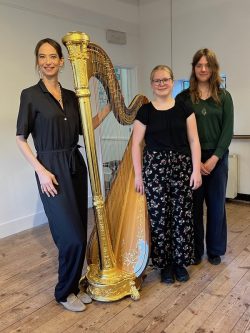 IF you are scared of spiders (and I am), the names Black Widow, Red Backed, Dancing White Lady or Tarantula are sure to send you into a near-catatonic state. But when they are the inspiration for an exciting piece of music, composed for the harp and played by an exceptionally talented young harpist, they do lose their terrors and become an exciting and enjoyable experience.
IF you are scared of spiders (and I am), the names Black Widow, Red Backed, Dancing White Lady or Tarantula are sure to send you into a near-catatonic state. But when they are the inspiration for an exciting piece of music, composed for the harp and played by an exceptionally talented young harpist, they do lose their terrors and become an exciting and enjoyable experience.
Charlotta Bommas, a 14 year old music student, was one of two young harpists who came to North Dorset for a three-day masterclass with the international Dutch-born star of the instrument, Gwyneth Wentink. At the end of the course, Charlotte and Nora Dijk, a 16 year old from the Netherlands, joined Gwyneth for a recital in the Mill Room at Springhead*, the environmental arts and education centre based in an ancient mill, set in glorious gardens with a lake, at Fontmell Magna.
It was a concert of delights and surprises, with a programme that ranged from music from the film, Willow, arranged for harp and played by Nora, to Charlotte’s interpretation of Spiders and Gwyneth playing an extract from Canto Ostinato, a compelling work by Dutch minimalist composer Simeon ten Holt, arranged for solo harp.
Charlotte began playing the harp at the age of five – as did Gwyneth – and showed a mastery of this demanding instrument that was mature beyond her years. Spiders, composed by Paul Patterson, was first performed by Sioned Williams at the Wigmore Hall in 1985. The composer says: “The very sight of the harp strings always reminds me of a spider’s web and perhaps the harpist’s hands and fingers could be likened to that of the spider weaving a complicated web. The idea to write a work called Spiders came to me after a visit to Australia where a great variety of spiders are to be found in abundance, and where incidentally I was almost bitten by a Red Backed, whose favourite spot is to wait under the toilet seat!”
The movements are named after four of the most deadly spiders, says Patterson: “The Dancing White Lady is a fast 7/8 movement with lots of crossed rhythms where the sight of legs flying in all directions could be visualised. Sharp irregular motifs represent the Red Backed Spider who sits patiently for its prey before it strikes with great speed. In the Black Widow movement, we enter the mysterious world of timelessness as the spider relentlessly weaves its web. The last movement, a tarantella, is a wild Neapolitan dance in triple time. It is believed to take its name from the Tarantula, whose poisonous bite is said to cause a ‘hysterical impulse to dance’.”
Canto Ostinato, composed between 1974 and 1979 for the piano, is a massive work (lasting up to four hours) which has almost cult status in the Netherlands. It is an intricate piece in which “time bends, spirals, loops back, implodes and explodes,” says Gwyneth, who has has recorded part of the work**, running to a bit under one hour, which will hopefully introduce a wider British audience to this haunting, complex, beautiful work.
In between the music, the three musicians answered questions and Gwyneth gave a brief description of the harp – in this case a magnificent gilded Italian-made instrument. The ability of the harp to be mesmeric, meditative and calming is well-known, but in these pieces we heard it as exciting, loud, dramatic, passionate, persuasive or even funny. It was a real eye-opener for many, as well as a welcome illustration of the acoustic qualities of the Mill Room.
I am still utterly terrified of spiders. Just not Paul Patterson’s version! FC
* www.springheadtrust.org.uk
** Canto Ostinato for solo harp, Gwyneth Wentink. Signum Classics, SIGCD907; www.signumrecords.com
Pictured: Gwyneth Wentink (left) with students Charlotte Bommas and Nora Dijk